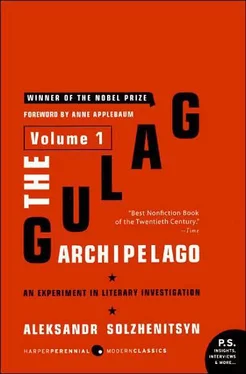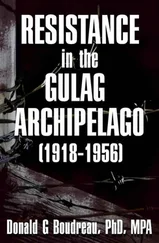3. Prisoners sentenced to death also suffered from hunger. They waited such a long time after the death sentence had been imposed that their principal sensation was no longer the fear of being shot but the pangs of hunger: where could they get something to eat? In 1941 Aleksandr Babich spent seventy-five days in a death cell in the Krasnoyarsk Prison. He had already reconciled himself to death and awaited execution as the only possible end to his unsuccessful life. But he began to swell up from starvation. At that point, they commuted his death sentence to ten years, and that was when he began his camp career. And what was the record stay in a death cell? Who knows? Vsevolod Petrovich Golitsyn, the elder of a death cell, so to speak, spent 140 days in it in 1938. But was that a record? The glory of Russian science, famed geneticist N. I. Vavilov, waited several months for his execution—yes, maybe even a whole year. As a prisoner still under death sentence he was evacuated to the Saratov Prison, where he was kept in a basement cell that had no window. When his death sentence was commuted in the summer of 1942, he was transferred to a general cell, and he could not even walk. Other prisoners carried him to the daily outdoor walk, supporting him under the arms.
4. Prisoners sentenced to death were given no medical attention. Okhrimenko was kept in a death cell for a long time in 1938, and he became very ill. Not only did they refuse to put him in the hospital, but the doctor took forever to come to see him. When she finally did come, she didn’t go into the cell; instead, without examining him or even asking him any questions, she handed him some powders through the bars. And fluid began to accumulate in Strakhovich’s legs—dropsy. He told the jailer about it—and they sent him, believe it or not, a dentist.
And when a doctor did enter the picture, was it right for him to cure the prisoner under sentence of death—in other words, to prolong his expectation of death? Or did humanitarianism dictate that the doctor should insist on execution as quickly as possible? Here is another little scene from Strakhovich: The doctor entered and, talking with the duty jailer, he pointed a finger at the prisoners awaiting execution: “He’s a dead man! He’s a dead man! He’s a dead man!” (He was pointing out to the jailer the victims of malnutrition and insisting that it was wrong to torment people so, that it was time to shoot them.)
What, in fact, was the reason for holding them so long? Weren’t there enough executioners? One must point out that the prison authorities often suggested to and even asked many of the condemned prisoners to sign appeals for commutation; and when prisoners objected strongly and refused, not wanting any more “deals,” they signed appeals in the prisoners’ names. And at the very least it took months for the papers to move through the twists and turns of the machine.
A clash between two different institutions was probably involved. The interrogatory and judicial apparatus—as we learned from the members of the Military Collegium, they were one and the same—anxious to expose nightmarish and appalling cases, could not impose anything less than a deserved penalty on the criminals—death. But as soon as the sentences had been pronounced and entered into the official record of interrogation and trial, the scarecrows now called condemned men no longer interested them. And, in actual fact, there hadn’t been any sedition involved, nor would the life of the state be affected in any way if these condemned men remained alive. So they were left entirely to the prison administration. And that administration, which was closely associated with Gulag, looked at prisoners from the economic point of view. To them the important figures were not an increase in the number of executions but an increase in the manpower sent out to the Archipelago.
And that is exactly the light in which Sokolov, the chief of the internal prison of the Big House in Leningrad, viewed Strakhovich, who finally became bored in the death cell and asked for paper and pencil for his scientific work. In a notebook he first composed “On the Interaction of a Liquid and a Solid Moving in It,” and then “Calculations for Ballistas, Springs and Shock Absorbers,” and then “Bases of the Theory of Stability.” They had already allotted him an individual “scientific” cell and fed him better, and questions began to come to him from the Leningrad Front. He worked out for them “Volumetric Weapons’ Fire Against Aircraft.” And it all ended with Zhdanov’s commuting his death sentence to fifteen years. (The mail from the mainland was slow, but soon his regular commutation order came from Moscow, and it was more generous than Zhdanov’s: merely a tenner.) [265]
And N.P., a mathematician with the rank of assistant professor, was exploited by the interrogator Kruzhkov (yes, yes, that same thief) for his personal ends. Kruzhkov was taking correspondence courses. And so he summoned P. from the death cell and gave him problems to solve in the theory of functions of a complex variable for Kruzhkov’s assignments (and probably they weren’t even his either).
So what did world literature understand about pre-execution suffering?
Finally, we learn from a story of Ch v that a death cell can be used as an element in interrogation, as a method of coercing a prisoner. Two prisoners in Krasnoyarsk who had refused to confess were suddenly summoned to a “trial,” “sentenced” to the death penalty, and taken to the death cell.
(Ch-v said: “They were subjected to a staged trial.” But in a context in which every trial is staged, what word can we use to distinguish this sort of pseudo trial from the rest? A stage on a stage, or a play within a play, perhaps?) They let them get a good swallow of that deathlike life. And then they put in stoolies who were allegedly sentenced to die also and who suddenly began to repent having been so stubborn during interrogation and begged the jailer to tell the interrogator that they were now ready to sign everything. They were given their confessions to sign and then taken out of the cell during the day—in other words, not to be shot.
And what about the genuine prisoners in that cell who had served as the raw material for the interrogators’ game? They no doubt experienced reactions of their own when people in there “repented” and were pardoned? Well, of course, but those are the producer’s costs, so to speak.
They say that Konstantin Rokossovsky, the future marshal, was twice taken into the forest at night for a supposed execution. The firing squad leveled its rifles at him, and then they dropped them, and he was taken back to prison. And this was also making use of “the supreme measure” as an interrogator’s trick. But it was all right; nothing happened; and he is alive and healthy and doesn’t even cherish a grudge about it.
And almost always a person obediently allows himself to be killed. Why is it that the death penalty has such a hypnotic effect? Those pardoned recall hardly anyone in their cell who offered any resistance. But there were such cases. In the Leningrad Kresty Prison in 1932, the prisoners sentenced to execution took the jailers’ revolvers away and opened fire. Following this, a different approach was adopted: After peering through the peephole to locate the person they wanted to take, they swarmed into the cell—five armed jailers at a time—and rushed to grab their man. There were eight prisoners under sentence of death in the cell, but every one of them, after all, had sent a petition to Kalinin and every one expected a commutation, and therefore: “You today, me tomorrow.” They moved away and looked on indifferently while the condemned man was tied up, while he cried out for help, while they shoved a child’s rubber ball into his mouth. (Now, looking at that child’s ball, could one really guess all its possible uses? What a good example for a lecturer on the dialectical method!)
Читать дальше












